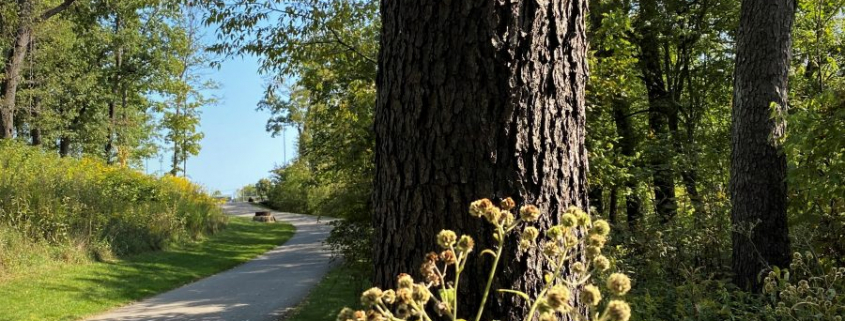A Suburban Trail within Sight of an Interstate Highway North of Pittsburgh, PA
Wildness is wherever you seek it, whether deep in the Appalachian forests… or hidden in plain sight within a suburban park.
Steve Jones
September 24, 2020, I hiked Brush Creek Trail in southern Butler County Pennsylvania, 20-miles north of Pittsburgh and within two miles of our son’s home in Cranberry Township. The linear Graham Park lies south and west of (and alongside) Interstate 76, paralleling Brush Creek. I walked the trail while our three grandkids were in school. Early fall had already arrived… a good month in advance of its onset here in northern Alabama. I wanted to chronicle the seasonal state of flowers, trees, and vegetation generally for this Blog Post… and expose the wildness that lies hidden within plain sight, even in the kind of suburban park found in most communities.
Brush Creek Trail in Butler County Pennsylvania
Graham is a classic suburban park, furnishing all manner of recreation fields, playgrounds, fitness stations, nature trails, and interpretive signage. The sound of semis on I-76 hummed without ebb. I attempted to tune it out so I could focus on the wildness we otherwise might not notice with the din of traffic, a distraction from Nature too often matched by our own digital devices. Far too many of us are awash in a sea of “other.”
I am nearly certain that few visitors realize that the greenway travels along a sewer line. The Brush Creek water treatment plant lies at the trail’s northern terminus. The plant treats 3.2 million gallons of wastewater daily. My favorite local greenways here in northern Alabama are likewise sewer line utility rights of way. What a great way to make silk out of a sow’s ear!
I will maintain a pretty good Post-pace reporting on key elements and core reflections with this photo-essay. I’ll begin by saying trail signage is excellent — I offer my compliments and appreciation to those responsible.
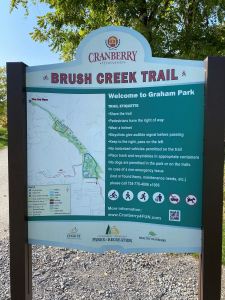
A gorgeous late-summer/early-fall day. Comfy temps and crystal blue sky. Open fields flanked by the paved trail and riparian forest. We all know that a picture is worth a thousand words. I will stay true to that old maxim, limiting my words to what I feel are necessary.
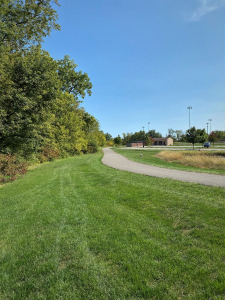
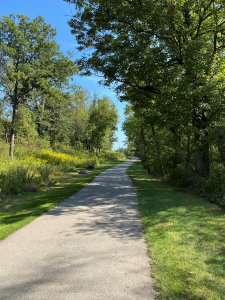
Aesthetic wooden fencing at culvert crossings, the trail bordered by lush early fall wildflowers.
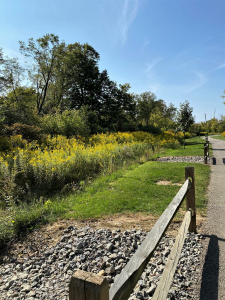
Urban park wildness comes in many forms, including this meadow under a power transmission line. The trick to full appreciation is to focus on the meadow…avoiding the view above. Remind yourself that without the power line, this 200-foot right-of-way might be populated with houses, streets, driveways, and mowed grass. Instead, we have a vibrant meadow habitat as home to diverse vegetation, small mammals, deer, countless songbirds, pollinators, and other insects essential to the meadow ecosystem. Don’t forget the birds of prey and foxes drawn by the small mammals!
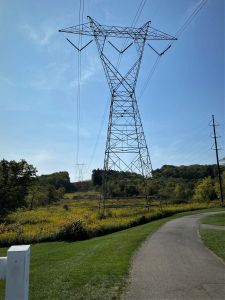
I often make the point that wildness is so often hidden in plain sight. Such is the case along Brush Creek Greenway. Each section below reveals the beauty, magic, wonder, and awe of Nature available within reach along a busy Interstate, under transmission line towers, and above a major sewer line.
Ponds, Creek, and Wetlands
Admittedly, I did not seek to understand the Brush Creek watershed. The area had not measured significant rains since earlier in the month. The ground seemed parched and the creek flow, I assumed, carried minimum flow, typical of late summer and early fall. Despite the low volume, I spotted small fish everywhere I encountered a pool. I flushed a great blue heron from bankside at a point close to the trail. At other locations I found beaver chews near the trail. Urban streams with riparian buffers attract all manner of wildlife.
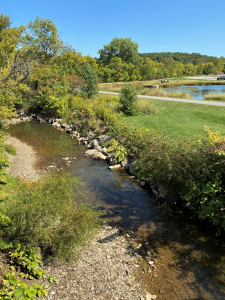
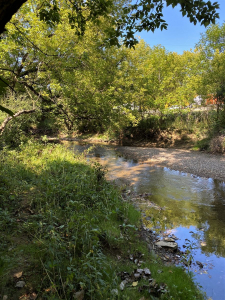
Below is a one-tenth-acre marshy area between the trail and the athletic fields beyond. The cattails evidence that efforts to sustain natural habitat within acres of mowed grass are paying dividends.
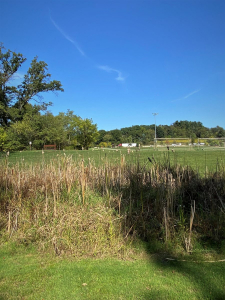
The creek bed ranges from natural (below left) to channeled with a trailside boulder bulkhead, which based upon my observations was the exception rather than the rule.
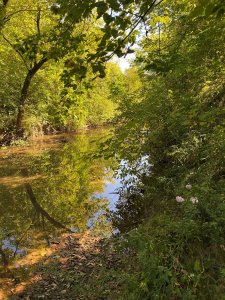
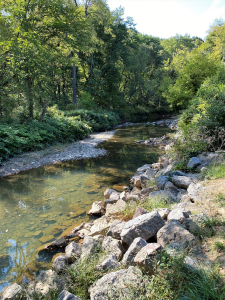
Because aquatic features dominate the Nature of Graham Park, managers offer interpretive signage to assure that park users have an opportunity to understand the natural ecosystem.
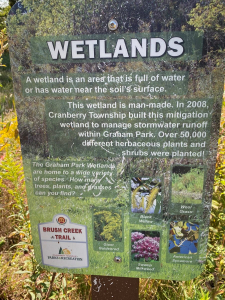
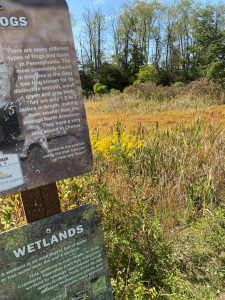
Again, all of this wildness…this sprawling and inviting classroom…all within sight and earshot of a busy Interstate highway just 20 miles from a major American city.
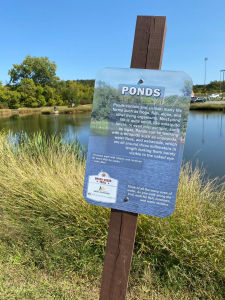
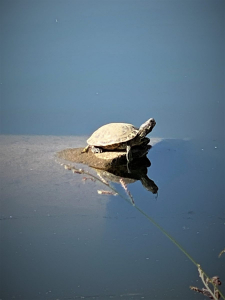
Birds love this land of edges, marshes, meadows, streams, ponds, brushland, and riparian forest. Bluebird houses line the greenway.
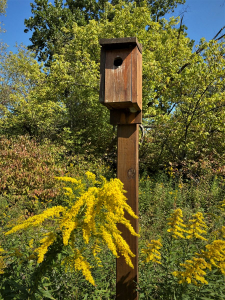
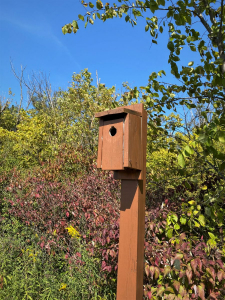
Truth is, I could have developed several Posts from my stroll along Brush Creek. I chose instead to stay broad and shallow…an eclectic slice across Nature’s suburban park panoply…a cornucopia of early fall delights. John Muir’s infinite storm of beauty.
Trees
I love the diverse ecosystem patchwork; but I am in love with forests, and the trees that compose them. As with other ecosystem elements, even though I want to delve deeply, I will not show favor by deepening the text in this section.
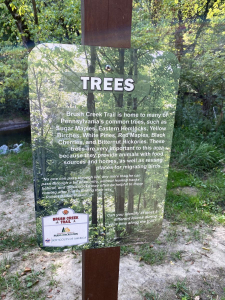
That’s a black cherry (Prunus serotina) below left. My doctoral research field studies focused on the Allegheny Hardwood forests, with cherry as the dominant species, just 100 miles north of Brush Creek. Black cherry is present in our north Alabama forests, but does not reach the more impressive dimensions that it does here in west central Pennsylvania. It reigns supreme on northward into the northwestern Pennsylvania Allegheny Plateau. That’s honey locust (Gleditsia triacanthos) below right, replete with its complex, multiply-forked thorns.
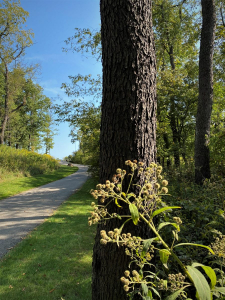
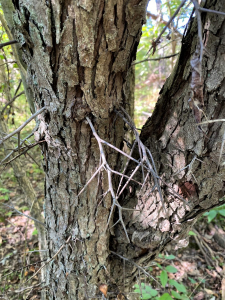
Cottonwood (Populus deltoides; below left) and shingle oak (Quercus imbricaria; below right) stood between the creek and trail.
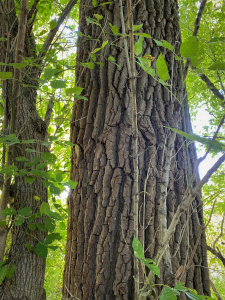
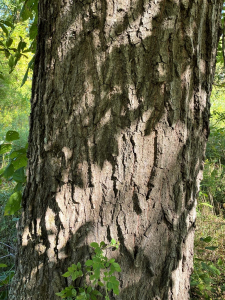
Likewise for black walnut (Juglans nigra; below left) and American basswood (Tilia americana; below right). Black walnut is a furniture standard, highly valued for centuries. Basswood offers neither the hardness (durability) or rich character pattern so cherished in walnut. The species often displays stump-cluster form.
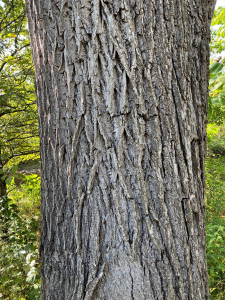
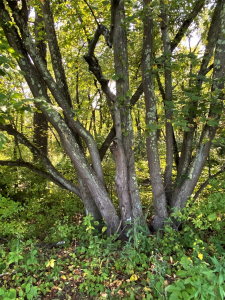
I catalogued two species of dogwood: grey dogwood (Cornus racemosa; below left) and flowering dogwood (Cornus florida; below right). Grey dogwood boasts white fruit; flowering dogwood berries are red.
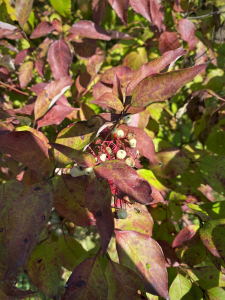
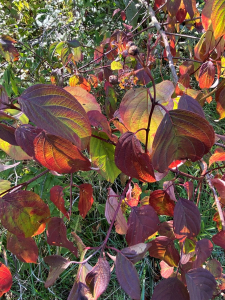
Note the pubescent (fuzzy) stem of staghorn sumac (Rhus typhina; below left) and hawthorn (Crataegus sp; below right). Although I am including these woody plants under the tree heading, I likely just insulted the cherry, walnut, oak, and cottonwood main canopy residents and forest dominants by daring to class these understory species as “trees”!
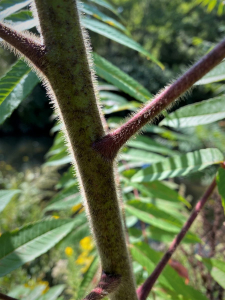
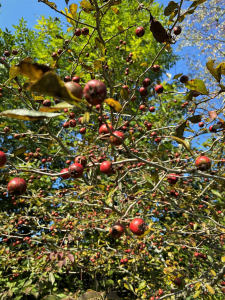
Again I note that I am simply providing a cross-sectional sampling of Nature on a single day in late-summer/early-fall. By no means am I offering an exhaustive inventory.
Flowers
The sign says, “There are a variety of flowers that can be seen along this trail…” Wow, what an understatement! There I was at just a brief snapshot of time along a 365-day continuing cycle. What could an informed regional botanist catalog over an entire year of hikes, venturing from streambank to meadow interior to full forested shade? I’m confident in guessing several hundred. Start with wetland skunk cabbage flowering in snow or under thin ice and extend beyond to the scores of flowers I spotted as the season reached past the autumnal equinox.
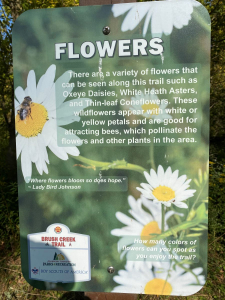
I give you just seven of the showstoppers, beginning with swamp aster (Symphyotrichum puniceum; below left. And smooth blue aster (Symphyotrichum laeve; below right).
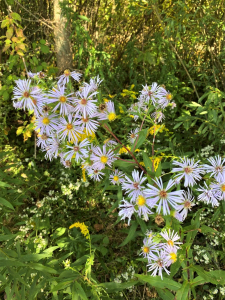
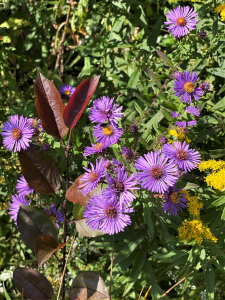
‘Tis the season for asters. I particularly liked the New England aster (Symphyotrichum novae–angliae) with its brilliant color, making a defiant statement as the first freeze lies just weeks (perhaps days) ahead.
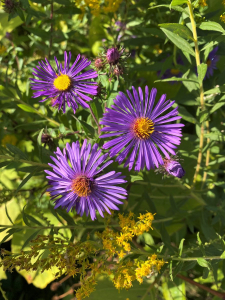
Wild carrot (Daucus carota; below left) offered its delicate lacy bouquet to my steadying hand. Naturalized from California to the eastern US, this species is native to Europe and Asia. Meadow evening primrose (Oenothera pilosella; below right) greeted me with its bright yellow sunshine, another fitting fare-thee-well to summer.
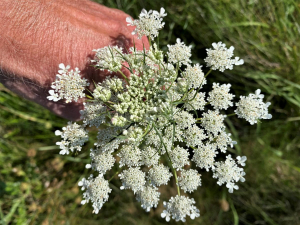
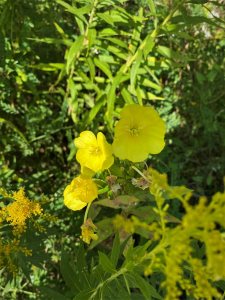
And what could make a stronger statement than New York Ironweed (Vernonia noveboracensis; below left)! Common from Florida into Canada, ironweed is yet another member of the aster family. Fall phlox (Phlox paniculata; below right) presented its closing argument, without the strength and volume of its ubiquitous April cousin, woodland phlox or sweet William.
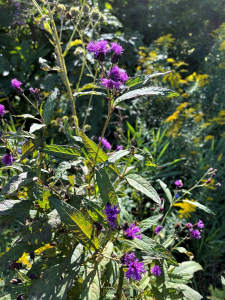
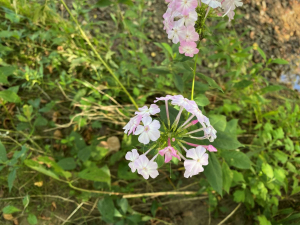
I have long been a champion of spring wildflowers, leaving summer bloomers to admirers who enjoy the summer heat more than I. However, retirement has opened my eyes and forced my ventures into Nature irrespective of seasonal bias. I admit to a long-held leaning toward the spring ephemerals, those hardy woodland flowers that brave the often cold shoulder season to capitalize on the brief period of full forest floor sunlight before forest canopy leaf-out. I am delighting now in all seasons, deepening and widening my field of appreciation. Nature’s beauty, magic, wonder, and awe know no limits.
Seasons
The best season, I’ve come to understand is whatever time I happen to venture forth. Any time I visit our son is an ideal time to discover what marvels Nature has to offer. The interpretive sign says it clearly, “There are many beautiful parts of each season to enjoy here.”
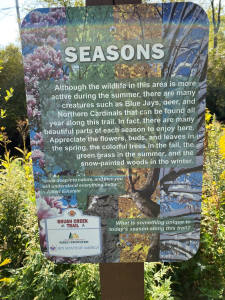
At the risk of stating the obvious, flowers are reproductive organs, ensuring species and ecosystem sustainability. From my earliest days, I’ve been a big fan of cattails (Typha latifolia; below left) with its corndog seed-head. Nearby I found the seed-head of Scirpus, a club-rush/bulrush, completing its annual cycle.
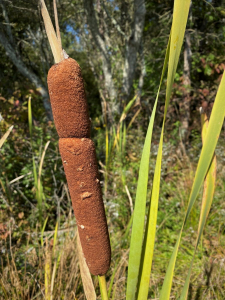
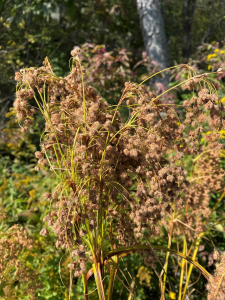
Right up there on my lifetime appreciation list are seedpods of common milkweed (Asclepias syriaca; below left). To this day I cannot resist, with or without a grandchild present, releasing the fairies into the breeze, dispersing the brown seeds to the four corners.
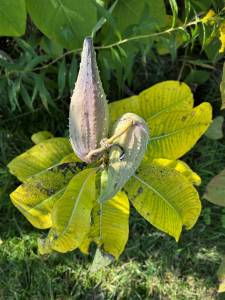
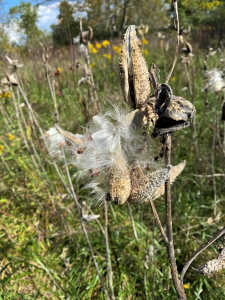
American pokeweed (Phytolacca americana) also ranks high. I admire its massive size — each year growing to 6-9 feet of red-stemmed elegance, with rich green leaves capturing sunlight and root-storing carbohydrates and energy to begin the cycle ground-up next spring. And there’s magic in those inky red berries hung with care for birds of many species for winter sustenance. If you are a mammalian species reading this, ignore the edible comment — pokeberries are quite toxic for humans and our fur-bearing kin.
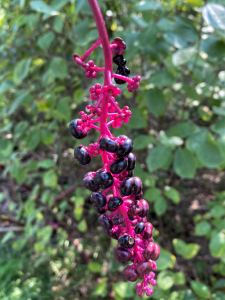
However, we have edible alternatives to pokeberry. Black walnut (we saw the tree earlier) is a staple in our American diet. They come nicely packaged in grocery stores (the same species as this wild walnut) for those of us not inclined to collect the fruit, dry it, husk it, then crack the nut to pick the meat. Squirrels consider the harvesting, preparation, storing, and consumption well worth the effort!
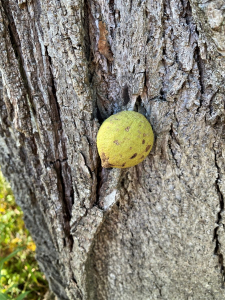
I’ll close with a flowering dogwood leaf in early fall splendor, its chlorophyll exiting the summer leaf across all but the vein margins, symbolizing the continuing seasonal flow. The color pattern is a literal and metaphorical expression of this stage in an annual cycle that is persistent, reliable, and exquisitely effective.
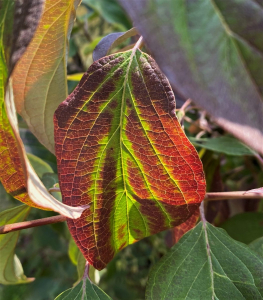
As I’ve noted time and again, wildness is where we seek it, whether in an urban park along a Pittsburgh-area Interstate highway or or a hundred miles north in the Tionesta Research Natural Area, a preserved remnant virgin beech-hemlock climax forest. Nature tells compelling tales wherever you encounter it.
Thoughts and Reflections
I offer three observations from my early fall exploration of a suburban park near Pittsburgh, Pennsylvania:
- Nature’s seasonal patterns are persistent, predictable, and exquisitely effective
- Any walk in wildness offers gifts across the seasons for those willing to look, see, understand, and appreciate
- John Muir — “In every walk with nature one receives far more than he seeks”
Inhale and absorb Nature’s elixir. May Nature Inspire, Inform, and Reward you!
Note: All blog post images created & photographed by Stephen B. Jones unless otherwise noted. Please circulate images with photo credit: “©2020 Steve Jones, Great Blue Heron LLC. All Rights Reserved.”
Another Note: If you came to this post via a Facebook posting or by an another route, please sign up now (no cost… no obligation) to receive my Blog Post email alerts: http://eepurl.com/cKLJdL
And a Third: I am available for Nature-Inspired Speaking, Writing, and Consulting — contact me at steve.jones.0524@gmail.com
Reminder of my Personal and Professional Purpose, Passion, and Cause
If only more of us viewed our precious environment through the filters I employ. If only my mission and vision could be multiplied untold orders of magnitude:
Mission: Employ writing and speaking to educate, inspire, and enable readers and listeners to understand, appreciate, and enjoy Nature… and accept and practice Earth Stewardship.
Vision:
- People of all ages will pay greater attention to and engage more regularly with Nature… and will accept and practice informed and responsible Earth Stewardship.
- They will see their relationship to our natural world with new eyes… and will understand more clearly their Earth home.
Tagline/Motto: Steve (Great Blue Heron) encourages and seeks a better tomorrow through Nature-Inspired Living!
Steve’s Three Books
I wrote my books Nature Based Leadership (2016), Nature-Inspired Learning and Leading (2017), and Weaned Seals and Snowy Summits: Stories of Passion for Place and Everyday Nature (2019; co-authored with Dr. Jennifer Wilhoit) to encourage all citizens to recognize and appreciate that every lesson for living, learning, serving, and leading is either written indelibly in or is powerfully inspired by Nature.
I began writing books and Posts for several reasons:
- I love hiking and exploring in Nature
- I see images I want to (and do) capture with my trusty iPhone camera
- I enjoy explaining those images — an educator at heart
- I don’t play golf!
- I actually do love writing — it’s the hobby I never needed when my career consumed me
- Judy suggested my writing is in large measure my legacy to our two kids, our five grand kids, and all the unborn generations beyond
- And finally, perhaps my books and Blogs could reach beyond family and touch a few other lives… sow some seeds for the future


All three of my books (Nature Based Leadership; Nature-Inspired Learning and Leading; Weaned Seals and Snowy Summits) present compilations of personal experiences expressing my (and co-author Dr. Wilhoit for Weaned Seals and Snowy Summits) deep passion for Nature. All three books offer observations and reflections on my relationship to the natural world… and the broader implications for society. Order any and all from your local indie bookstore, or find them on IndieBound or other online sources such as Amazon and LifeRich.

